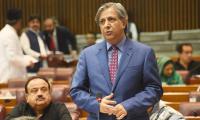LAHORE: Public outcry against runaway food inflation is universal and Pakistan is no exception as unaffordable edibles have been the main reason behind many agitation movements that led to the downfall of different governments and even those that pursued promising economic policies.
Ayub Khan’s ten years’ tenure is known as the best economic era of the country. It was during that period the country was rapidly industrialised and saw its first and only green revolution. The unrest that finally toppled his government started with the increase of Rs0.25 in the retail price of sugar. The Musharaf regime also had an excellent economic growth record. He was confident that his supporters would win the next election. But when the government loosened its grip on hoarders and manipulators in the election year his party was nowhere to be seen.
After Musharraf, the PPP government that assumed power was not so competent. The wheat flour rates were already high when it took over and wheat cultivation was not far away. It almost doubled the wheat support price. The new wheat price even then was lower than the prevailing wheat rates when it took the helms of affairs. In a way the wheat flour prices remained the same but growers sowed record wheat and harvested bumper crops. The benefit of higher prices passed on to the farmers and reduced poverty in rural areas.
The smuggling of wheat was effectively stopped as its prices in Pakistan were higher than the global market. It was during this PPP tenure that Pakistan witnessed highest inflation during its first two years. The rupee also depreciated very sharply against the dollar. The depreciation resulted in an increase in non-food imported items but the exports also increased from $20 billion to $25 billion. Still the government survived because the price of wheat and vegetables were stable, and the inflation impacted the rich more than the poor. It also committed the mistake of higher spending in the election year that easily brought the PML-N into power.
The PML-N government operated with a plan. It was lucky as well because the commodity rates nosedived during its period. The crude oil import bill reduced sharply that tamed inflation into single digits in its first year and below 6 percent in the next four. The rupee remained stable throughout this period which the present rulers call Ishaq Dar gimmick.
However, the PTI government realised its folly of exposing rupee to manipulators and used Dar’s trick to stabilise the currency. It is interesting to note that the PML-N government withstood 126 days of Dharna in Islamabad that marginalised activities in the federal capital. It had an electorate (a silent majority) at its side even though industrialisation suffered badly during that period. The job losses in the industrial sector were compensated by job creation in the construction and services sectors. The China-Pakistan Economic Corridor project was launched in the second year of PML-N tenure with funds coming from China. The projects were commissioned with astonishing speed. That project created millions of jobs in the construction sector where housing activities also picked up. The major jobless workforces in Pakistan are always unskilled workers; the construction boom in fact resulted in shortage of workers at many places.
The exports however suffered badly as the PML-N refused to subsidise the exporting sectors, particularly textiles. At one time exports were reduced to $21 billion but then started steadily increasing. In its last year, the exports crossed $24 billion, still short by about $1 billion achieved in the last year of the PPP government. The GDP growth otherwise constantly picked up from 3 percent to 5.8 percent in its last year. The PML-N government took a conscious decision to keep the prices of around 13 essential items stable. It was successful in keeping food inflation low and survived comfortably even in the last two years after Nawaz was disqualified. His public popularity is still undisputed.
The PTI government after assuming power blamed the past regimes for the economic woes of the country. People believed the ruling party in the first six months but when things started deteriorating beyond their tolerance the criticism started first mutely and then openly. The rupee depreciated massively during the first two years but the exports in fact declined marginally during this period. Even in July-September this fiscal the exports are less than they were in the same period in FY2017.
The cost of living increased for all segments of society, more so for the poor. The de-industrialisation is on, people have lost jobs. Food prices have touched record high. The Musharaf regime faced public music because of an increase in wheat flour rates and Ayub’s downfall was due to a 20 percent increase in sugar prices. This time the wheat and sugar rates have doubled. There is no justification for this increase. People are certainly not pleased with this performance as many of them are forced to live semi-starved lives.
Chinese power company had intended to acquire up to 18.336 billion ordinary shares of K-Electric, representing 66.4...
MARI also successfully drilled and tested another appraisal well in the Mari Ghazij formation located in Mari D&PL
Gold rates decreased by $30 to $2,381 per ounce in the international market
Growing number of Americans have seen their savings dwindle as rising prices squeeze budgets while interest rates stay...
IMF will closely watch the privatization of PIA by the end of June
PSX lays down the groundwork to encourage listed companies to adopt ESG reporting in line with global standards







